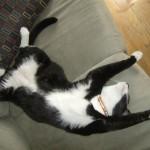Posted by Anne M on Tuesday, Nov 5, 2013
Last month, I heard John Bradshaw on Fresh Air with Terry Gross explaining that cats do not necessarily sit on us for our warmth, they sit on us because we are friends. I liked the thought of this. I always believed that Gatsby (my cat) and I are in good standing, but can you ever really say you are friends with your cat? Well, I do, but I fully acknowledge that it is a complicated relationship. There are times I wouldn't argue with someone that says cats are only in it for the food.
Cat Sense, John Bradshaw's latest pet science book, doesn't just reinforce good feelings about having my cat around. He discusses the latest studies on cat behavior to explain some of their habits, provides advice on how to interpret whether cats are comfortable with their environment, and explains how to manage their undesirable innate behavior, such as the need to hunt or the inability to get along with other cats. Bradshaw is concerned that cats need to adapt to modern expectations. We want friendly cats who, for the most part, live indoors, leave songbirds alone, and coexist with other cats or with dogs in the home. And we are asking for this rather quickly. Bradshaw puts this in perspective by providing an interesting history of how the cat has evolved as one of our companions.
 I'm pretty sure that Gatsby bears me no ill will seeing as how he seems to feel extremely safe when he sleeps as illustrated in the accompanying photograph.
I'm pretty sure that Gatsby bears me no ill will seeing as how he seems to feel extremely safe when he sleeps as illustrated in the accompanying photograph.
If you are not a cat person, Bradshaw's previous book covered the same issues with dogs.


To cut to the chase, I couldn't put this novel down. It is a research mystery about a family past, which I loved. It is also beautifully written. It is also a novel rooted in truth. There really was a postcard and it was really sent to Anne Berest's mother. And Anne Berest and her mother did conduct this family research. But the fictionalized elements fill in the gap of the history that was erased--the stories of Berest's great-grandparents and great aunt and uncle could not pass down. Their memories were extinguished at Auschwitz If you appreciate the role that novels play in showing you something, "The Postcard" is the novel that encapsulates the idea of inherited trauma. -Anne M